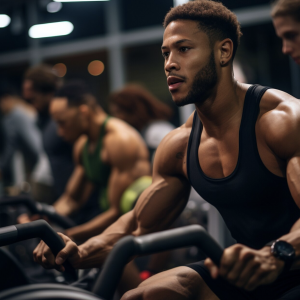
Introduction
Fitness is not just about hitting the gym or running marathons; it encompasses a holistic approach to health that includes physical, mental, and emotional well-being. This guide explores various aspects of fitness, providing valuable insights and practical tips to help you embark on your journey to a healthier, fitter life.
Understanding Fitness
Fitness is the state of being physically fit and healthy, achieved through regular physical activity, proper nutrition, and adequate rest. It is crucial for overall well-being, as it enhances energy levels, boosts mood, and reduces the risk of chronic diseases.
The Components of Fitness
- Cardiovascular Endurance: The ability of the heart and lungs to supply oxygen-rich blood to the working muscles during sustained physical activity. Activities such as running, swimming, and cycling improve cardiovascular endurance.
- Muscular Strength: The maximum force that a muscle or group of muscles can exert against a resistance. Weightlifting and bodyweight exercises are excellent for building strength.
- Muscular Endurance: The ability of a muscle or group of muscles to sustain repeated contractions against resistance for an extended period. Circuit training and high-repetition weightlifting can enhance muscular endurance.
- Flexibility: The range of motion available at a joint. Stretching exercises and activities like yoga improve flexibility.
- Body Composition: The ratio of fat to lean mass in the body. Maintaining a healthy body composition involves a balanced diet and regular exercise.
The Importance of Fitness
Regular physical activity offers numerous benefits, including:
- Improved Mental Health: Exercise releases endorphins, which help reduce stress, anxiety, and depression.
- Enhanced Physical Health: Regular activity strengthens the heart, lungs, muscles, and bones, reducing the risk of chronic diseases like diabetes, hypertension, and osteoporosis.
- Increased Longevity: Active individuals tend to live longer, healthier lives.
- Better Quality of Life: Fitness enhances overall quality of life, making daily tasks easier and improving mobility and independence.
Starting Your Fitness Journey
Embarking on a fitness journey can be daunting, but with the right approach, it can be a rewarding experience.
Setting Realistic Goals
Setting achievable and realistic fitness goals is crucial. Start with small, manageable objectives and gradually increase the difficulty as you progress. Goals should be SMART: Specific, Measurable, Achievable, Relevant, and Time-bound.

Choosing the Right Exercise Routine
Selecting an exercise routine that suits your interests and fitness level is vital. Here are some popular fitness routines:
- Cardiovascular Exercises: Running, cycling, swimming, and aerobic classes are excellent for improving cardiovascular health.
- Strength Training: Weightlifting, resistance band exercises, and bodyweight workouts help build muscle and increase strength.
- Flexibility and Balance: Yoga, Pilates, and stretching routines enhance flexibility and improve balance.
- High-Intensity Interval Training (HIIT): Short bursts of intense exercise followed by rest periods. HIIT is effective for burning calories and improving cardiovascular fitness.
- Recreational Activities: Sports, dancing, and outdoor activities like hiking and kayaking are fun ways to stay active.
Creating a Balanced Workout Plan
A well-rounded workout plan includes a mix of cardiovascular, strength, and flexibility exercises. Here’s a sample weekly plan:
- Monday: 30 minutes of running + 20 minutes of strength training (upper body)
- Tuesday: 45 minutes of cycling + 15 minutes of stretching
- Wednesday: 30 minutes of swimming + 20 minutes of strength training (lower body)
- Thursday: Rest day or light activity like walking
- Friday: 30 minutes of HIIT + 20 minutes of yoga
- Saturday: 1-hour hiking or recreational sport
- Sunday: Rest day

Nutrition and Fitness
Proper nutrition is integral to fitness. Fueling your body with the right nutrients enhances performance, aids recovery, and promotes overall health.
Macronutrients
- Carbohydrates: The primary energy source for exercise. Include whole grains, fruits, and vegetables in your diet.
- Proteins: Essential for muscle repair and growth. Incorporate lean meats, fish, eggs, dairy, beans, and nuts.
- Fats: Necessary for hormone production and energy. Opt for healthy fats like avocados, nuts, seeds, and olive oil.
Micronutrients
Vitamins and minerals play a critical role in energy production, immune function, and bone health. Ensure a varied diet rich in fruits, vegetables, whole grains, and lean proteins.
Hydration
Staying hydrated is crucial, especially during exercise. Drink plenty of water throughout the day and consider electrolyte-rich drinks during intense workouts.
Pre- and Post-Workout Nutrition
- Pre-Workout: Consume a balanced meal or snack containing carbohydrates and proteins 1-2 hours before exercising.
- Post-Workout: Refuel with a mix of proteins and carbohydrates within 30 minutes of completing your workout to aid recovery.

Overcoming Fitness Challenges
Staying committed to a fitness routine can be challenging. Here are some common obstacles and tips to overcome them:
Lack of Time
- Solution: Incorporate shorter, more intense workouts like HIIT. Break exercise into smaller sessions throughout the day.
Motivation
- Solution: Set clear goals, track progress, and reward yourself for achievements. Find a workout buddy or join a fitness community for support.
Boredom
- Solution: Vary your routine by trying new activities or changing your workout environment. Listen to music or podcasts to make exercise more enjoyable.
Plateaus
- Solution: Mix up your workouts to challenge your body in new ways. Increase the intensity, duration, or try different exercises.
Fitness for Different Life Stages
Fitness needs and capabilities change with age. Here’s a guide to staying active at various life stages:
Children and Adolescents
Encourage physical activity through play, sports, and family activities. Focus on fun and developing a lifelong love for movement.

Adults
Balance cardiovascular, strength, and flexibility exercises. Incorporate activities that fit your lifestyle and interests.
Older Adults
Focus on maintaining mobility, balance, and strength. Low-impact activities like walking, swimming, and yoga are excellent choices.
Special Considerations
If you have a medical condition or are pregnant, consult with a healthcare professional before starting a new exercise routine. Adapt activities to suit your needs and ensure safety.
The Role of Technology in Fitness
Technology has revolutionised fitness, offering innovative ways to stay active and track progress.
Fitness Apps
Fitness apps provide workout plans, track progress, and offer virtual coaching. Popular apps include MyFitnessPal, Strava, and Nike Training Club.
Wearable Devices
Wearable fitness trackers monitor activity levels, heart rate, and sleep patterns. Devices like Fitbit, Garmin, and Apple Watch help you stay on top of your fitness goals.
Online Workouts
Online platforms offer a variety of workout videos and live classes. Websites like YouTube, Peloton, and Fitness Blender provide access to diverse fitness routines.
Virtual Reality (VR)
VR fitness games and applications offer immersive workout experiences. Products like Oculus Quest and Supernatural make exercise fun and engaging.
Mind-Body Connection
Fitness is not just physical; it involves a strong mind-body connection.
Mindfulness and Meditation
Incorporating mindfulness and meditation into your fitness routine can reduce stress, improve focus, and enhance overall well-being. Practices like yoga and tai chi integrate physical activity with mental relaxation.
Mental Health Benefits
Regular exercise has profound effects on mental health. It reduces symptoms of depression and anxiety, improves mood, and boosts self-esteem. Engaging in physical activity can also enhance cognitive function and protect against cognitive decline.
Staying Safe and Preventing Injuries
Safety is paramount in any fitness routine. Here are tips to prevent injuries and stay safe:
Warm-Up and Cool-Down
Always start with a warm-up to prepare your body for exercise and end with a cool-down to aid recovery. Include dynamic stretches in your warm-up and static stretches in your cool-down.
Listen to Your Body
Pay attention to your body’s signals. If you experience pain, dizziness, or shortness of breath, stop exercising and seek medical advice.
Proper Technique
Using the correct technique is crucial to prevent injuries. If you’re unsure, consider hiring a personal trainer or taking classes to learn the proper form.
Rest and Recovery
Allow your body time to rest and recover. Include rest days in your routine and ensure you get adequate sleep.
Equipment
Use appropriate equipment and ensure it is in good condition. Wear suitable footwear and clothing for your activity.
Conclusion
Fitness is a lifelong journey that encompasses physical, mental, and emotional well-being. By setting realistic goals, choosing the right activities, and maintaining a balanced approach to nutrition and exercise, you can achieve and sustain a healthy, active lifestyle. Embrace the journey, stay motivated, and enjoy the myriad benefits that fitness brings to your life.


